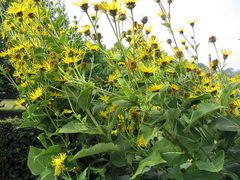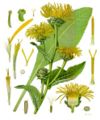Elecampane
| Inula helenium subsp. var. | Elecampane | |||||||||||||||||||||||||||||||||||||||||||||||||||||||
|---|---|---|---|---|---|---|---|---|---|---|---|---|---|---|---|---|---|---|---|---|---|---|---|---|---|---|---|---|---|---|---|---|---|---|---|---|---|---|---|---|---|---|---|---|---|---|---|---|---|---|---|---|---|---|---|---|

|
|
| ||||||||||||||||||||||||||||||||||||||||||||||||||||||
| ||||||||||||||||||||||||||||||||||||||||||||||||||||||||
Elecampane, also called Horse-heal (Inula helenium) or Marchalan (in Welsh), is a perennial composite plant common in many parts of Great Britain, and ranges throughout central and Southern Europe, and in Asia as far eastwards as the Himalayas.
It is a rather rigid herb, the stem of which attains a height of from 3 to 5 feet; the leaves are large and toothed, the lower ones stalked, the rest embracing the stem; the flowers are yellow, 2 inches broad, and have many rays, each three-notched at the extremity. The root is thick, branching and mucilaginous, and has a warm, bitter taste and a camphoraceous odor.
| Standard Cyclopedia of Horticulture |
|---|
|
Inula helenium, Linn. Elecampane. Tall, thick-stemmed: lvs. unequally dentate-serrate; root- lvs. elliptic-oblong, narrowed into a petiole; st.-lvs. half-clasping, cordate-oblong: outer involucral parts leafy, ovate. Wet, sandy and mountainous regions. Eu., N. Asia. Naturalized in Amer. — The roots are thick and carrot-like. For medicinal purposes, 2-year- old roots should be dug in Aug. lf older, they are likely to be stringy and woody.
|
Cultivation
Propagation
Pests and diseases
Varieties
Gallery
-
photo 1
-
photo 2
-
photo 3
References
- Standard Cyclopedia of Horticulture, by L. H. Bailey, MacMillan Co., 1963
External links
- w:Elecampane. Some of the material on this page may be from Wikipedia, under the Creative Commons license.
- Elecampane QR Code (Size 50, 100, 200, 500)

